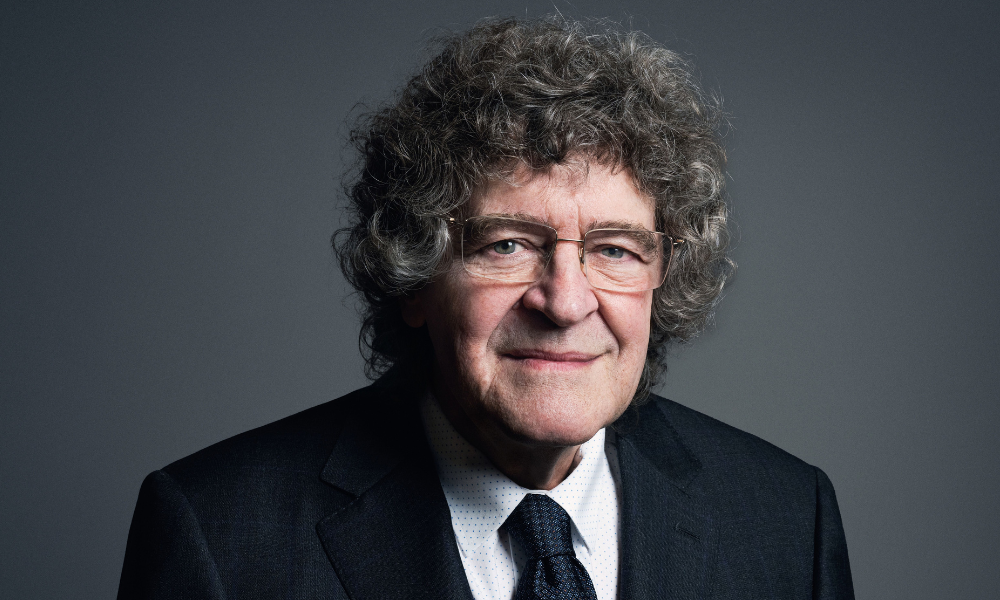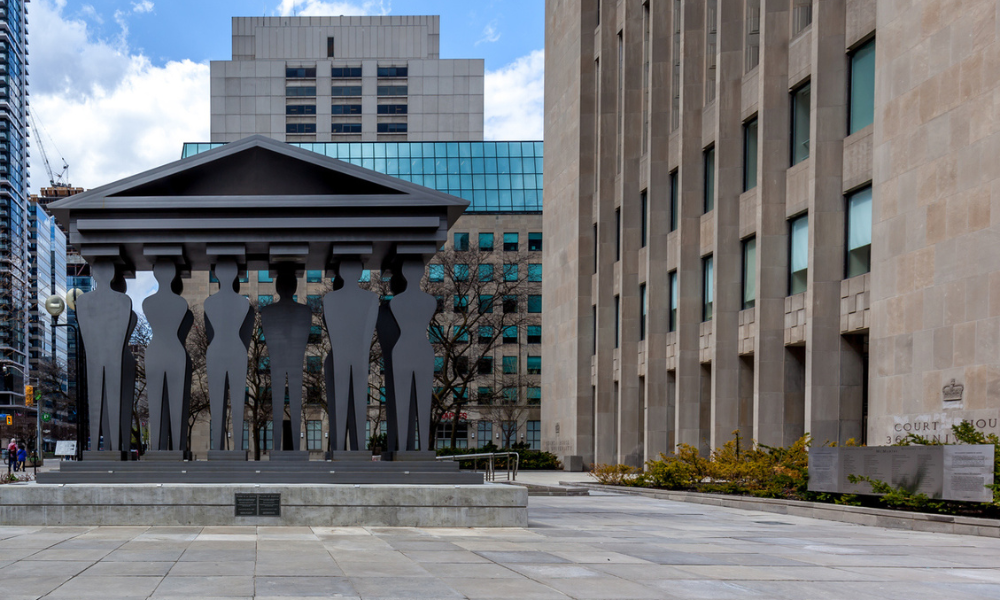In the wake of the City of Toronto’s financial crisis, the Toronto Police Services Board plans to take another stab at asking the province to pay for at least part of the escalating costs of security in Toronto courtrooms.
The cost of court security has skyrocketed from $16 million in 1990 to $43.5 million this year, and to an expected $47 million next year.
On Aug. 9, the Toronto Police Services Board unanimously passed a motion to send Toronto’s Police Chief Bill Blair and board chairman Alok Mukherjee to meet with Attorney General Michael Bryant and Ontario’s Chief Justice Warren Winkler about finding ways to reduce the cost of court security and to try to convince the province to consider sharing these costs.
Another motion passed at the same meeting will require Blair to consider ways of reducing the cost of court security without affecting the level of security, Mukherjee told Law Times.
Toronto’s mayor David Miller, also a member of the Police Services Board, introduced both motions.
“The question is whether it’s proper for the municipal police board to bear the full cost of court security in a city like Toronto, where the courtrooms are actually used by people from across the province,” said Mukherjee.
“We are the only province in Canada where there is no sharing of the cost of court security between the province and the police board.”
Over the past 10 years, the number of courtrooms in Toronto has doubled and the current number of courtrooms hovers around 260, he said.
Every time new courtrooms are built, the police department must hand over the requested number of officers, without receiving any financial help from the province, and without having any input about the necessary level of security, he said.
“If the attorney general says I’m going to open six new courtrooms in Toronto and the judges of those courtrooms say we need to provide four officers in each of those courtrooms, our understanding is that we have to provide those 24 officers.
“But if, in building those courtrooms or in renting space to build the courtrooms, the police service board was involved in choosing the location, in determining how to best provide security, and so on, then we might figure there are other ways to provide security that doesn’t require us to pull 24 officers off the streets, right? At the present time, we don’t have that authority.
“If we were planning security, then we would be able to say two officers would be sufficient, or whatever.
“What we are saying is that there must be some way . . . either the province shares the cost, or, as in some other provinces, pays the cost. If you are going to open a new courtroom, you pay for it.”
The day after the meeting, the Ontario Bar Association issued a press release, saying it strongly opposes any reduction of security officers in Toronto courtrooms.
“Courtrooms are emotionally charged environments,” said OBA president James Morton. “Police, witnesses, and victims of crime are put at risk if there is not sufficient security. By the very nature of the courts, our most vulnerable are put in close proximity with our most violent citizens. Security here is essential.
“We appreciate the challenges that municipalities and the province face with the rising cost of providing court security in our courts. But we strongly feel that the debate between the levels of government should be on who ultimately pays, not what is the risk-ratio that we are willing to chance. Safe and secure courts are not an option - they are an essential government service.”
Court security is becoming even more critical as courts get busier, and gaps in court security still exist, Morton told Law Times.
Justices of the peace do not have chambers with the other judicial officers in many courthouses in Toronto and throughout the province, he said.
“So they are walking through the halls unaccompanied by security, past the families of people they’ve just denied bail to,” he says. “They are in significant danger.”
And in the Old City Hall courthouse in downtown Toronto, there are no judges’ corridors, so both judges and justices of the peace often walk through the halls without escorts, he said.
But Mukherjee said, to his knowledge, no judge or justice of the peace has written to him or to Blair with concerns about the level of courtroom security.
“I’m not aware of any judge or any prisoner or any witness, or any lawyer for that matter, that has been physically harmed or threatened since the court security responsibility has been downloaded to the local police service [in 1995].”
However, at a Canadian Bar Association conference last week in Calgary, former RCMP commissioner Norman Inkster said there is a worrying trend toward greater violence as the courts deal with high-profile trials, which is raising questions about who should provide court security and who should pay for it.
“It is not unreasonable to conclude that the trend will be towards more incidents of violence, not fewer,” he said.
“Security is often at the lowest edge of the budget concerns until something happens,” he said.
It would help if an organization, such as the CBA, held a mini-symposium on the issue, so that experts could share data, experiences, and approaches, he said.
Also at the conference, Chief Justice François Rolland of the Superior Court of Quebec reported that incidents of varying seriousness take place daily in Canadian courtrooms and are on the rise, even though the media does not always report them.
In Montreal, for example, court security personal arrest an average of two people every day, mostly for threats or assaults. One person recently jumped over a railing leading toward a judge, he said.
“Both objective security and the impression of being safe are essential for the well-being and peace of mind of the users of our courthouses and the proper functioning of our judicial system.”
“To ensure these goals in public places, such as our courthouses, requires committing significant financial, material, and political resources.”
“The situation existing in Montreal and in the province of Quebec is not unique in Canada.”
“One thing is obvious, we must act and we must act soon,” said Rolland.
Miller has been looking for ways to cut costs since Toronto’s city council voted to defer a vote on two new taxes until Oct. 22. The taxes would have given the city $350 million toward its projected budget shortfall next year.
So far, Blair has determined he can trim $3 million from the police budget this year.
Last week, Toronto city manager Shirley Hoy announced $34 million in sweeping cuts to city services this year. The cuts will reduce next year’s operating budget shortfall of $575 million by at least $83 million.
One of the cuts will mean longer wait times for customers calling provincial offences court phone lines for information about things like traffic tickets.
Half of the court services staff will be redeployed to more essential services, and customers can expect to wait 20 minutes before speaking to an actual person. The changes will not impact criminal courts.
“We generally handle about 400 calls a day,” said Barry Randell, director of Toronto court services. “We probably will only be able to handle 200 calls a day.”
The answers to many common questions are available on the internet, or by listening to a lengthy automated information system, he said.
“No doubt, there will be some difficult situations where people have to wait,” he says. “If people are concerned about not being able to get to court on time, they may find it quite an inconvenience, which is unfortunate.”
With files from Helen Burnett.
The cost of court security has skyrocketed from $16 million in 1990 to $43.5 million this year, and to an expected $47 million next year.
On Aug. 9, the Toronto Police Services Board unanimously passed a motion to send Toronto’s Police Chief Bill Blair and board chairman Alok Mukherjee to meet with Attorney General Michael Bryant and Ontario’s Chief Justice Warren Winkler about finding ways to reduce the cost of court security and to try to convince the province to consider sharing these costs.
Another motion passed at the same meeting will require Blair to consider ways of reducing the cost of court security without affecting the level of security, Mukherjee told Law Times.
Toronto’s mayor David Miller, also a member of the Police Services Board, introduced both motions.
“The question is whether it’s proper for the municipal police board to bear the full cost of court security in a city like Toronto, where the courtrooms are actually used by people from across the province,” said Mukherjee.
“We are the only province in Canada where there is no sharing of the cost of court security between the province and the police board.”
Over the past 10 years, the number of courtrooms in Toronto has doubled and the current number of courtrooms hovers around 260, he said.
Every time new courtrooms are built, the police department must hand over the requested number of officers, without receiving any financial help from the province, and without having any input about the necessary level of security, he said.
“If the attorney general says I’m going to open six new courtrooms in Toronto and the judges of those courtrooms say we need to provide four officers in each of those courtrooms, our understanding is that we have to provide those 24 officers.
“But if, in building those courtrooms or in renting space to build the courtrooms, the police service board was involved in choosing the location, in determining how to best provide security, and so on, then we might figure there are other ways to provide security that doesn’t require us to pull 24 officers off the streets, right? At the present time, we don’t have that authority.
“If we were planning security, then we would be able to say two officers would be sufficient, or whatever.
“What we are saying is that there must be some way . . . either the province shares the cost, or, as in some other provinces, pays the cost. If you are going to open a new courtroom, you pay for it.”
The day after the meeting, the Ontario Bar Association issued a press release, saying it strongly opposes any reduction of security officers in Toronto courtrooms.
“Courtrooms are emotionally charged environments,” said OBA president James Morton. “Police, witnesses, and victims of crime are put at risk if there is not sufficient security. By the very nature of the courts, our most vulnerable are put in close proximity with our most violent citizens. Security here is essential.
“We appreciate the challenges that municipalities and the province face with the rising cost of providing court security in our courts. But we strongly feel that the debate between the levels of government should be on who ultimately pays, not what is the risk-ratio that we are willing to chance. Safe and secure courts are not an option - they are an essential government service.”
Court security is becoming even more critical as courts get busier, and gaps in court security still exist, Morton told Law Times.
Justices of the peace do not have chambers with the other judicial officers in many courthouses in Toronto and throughout the province, he said.
“So they are walking through the halls unaccompanied by security, past the families of people they’ve just denied bail to,” he says. “They are in significant danger.”
And in the Old City Hall courthouse in downtown Toronto, there are no judges’ corridors, so both judges and justices of the peace often walk through the halls without escorts, he said.
But Mukherjee said, to his knowledge, no judge or justice of the peace has written to him or to Blair with concerns about the level of courtroom security.
“I’m not aware of any judge or any prisoner or any witness, or any lawyer for that matter, that has been physically harmed or threatened since the court security responsibility has been downloaded to the local police service [in 1995].”
However, at a Canadian Bar Association conference last week in Calgary, former RCMP commissioner Norman Inkster said there is a worrying trend toward greater violence as the courts deal with high-profile trials, which is raising questions about who should provide court security and who should pay for it.
“It is not unreasonable to conclude that the trend will be towards more incidents of violence, not fewer,” he said.
“Security is often at the lowest edge of the budget concerns until something happens,” he said.
It would help if an organization, such as the CBA, held a mini-symposium on the issue, so that experts could share data, experiences, and approaches, he said.
Also at the conference, Chief Justice François Rolland of the Superior Court of Quebec reported that incidents of varying seriousness take place daily in Canadian courtrooms and are on the rise, even though the media does not always report them.
In Montreal, for example, court security personal arrest an average of two people every day, mostly for threats or assaults. One person recently jumped over a railing leading toward a judge, he said.
“Both objective security and the impression of being safe are essential for the well-being and peace of mind of the users of our courthouses and the proper functioning of our judicial system.”
“To ensure these goals in public places, such as our courthouses, requires committing significant financial, material, and political resources.”
“The situation existing in Montreal and in the province of Quebec is not unique in Canada.”
“One thing is obvious, we must act and we must act soon,” said Rolland.
Miller has been looking for ways to cut costs since Toronto’s city council voted to defer a vote on two new taxes until Oct. 22. The taxes would have given the city $350 million toward its projected budget shortfall next year.
So far, Blair has determined he can trim $3 million from the police budget this year.
Last week, Toronto city manager Shirley Hoy announced $34 million in sweeping cuts to city services this year. The cuts will reduce next year’s operating budget shortfall of $575 million by at least $83 million.
One of the cuts will mean longer wait times for customers calling provincial offences court phone lines for information about things like traffic tickets.
Half of the court services staff will be redeployed to more essential services, and customers can expect to wait 20 minutes before speaking to an actual person. The changes will not impact criminal courts.
“We generally handle about 400 calls a day,” said Barry Randell, director of Toronto court services. “We probably will only be able to handle 200 calls a day.”
The answers to many common questions are available on the internet, or by listening to a lengthy automated information system, he said.
“No doubt, there will be some difficult situations where people have to wait,” he says. “If people are concerned about not being able to get to court on time, they may find it quite an inconvenience, which is unfortunate.”
With files from Helen Burnett.







